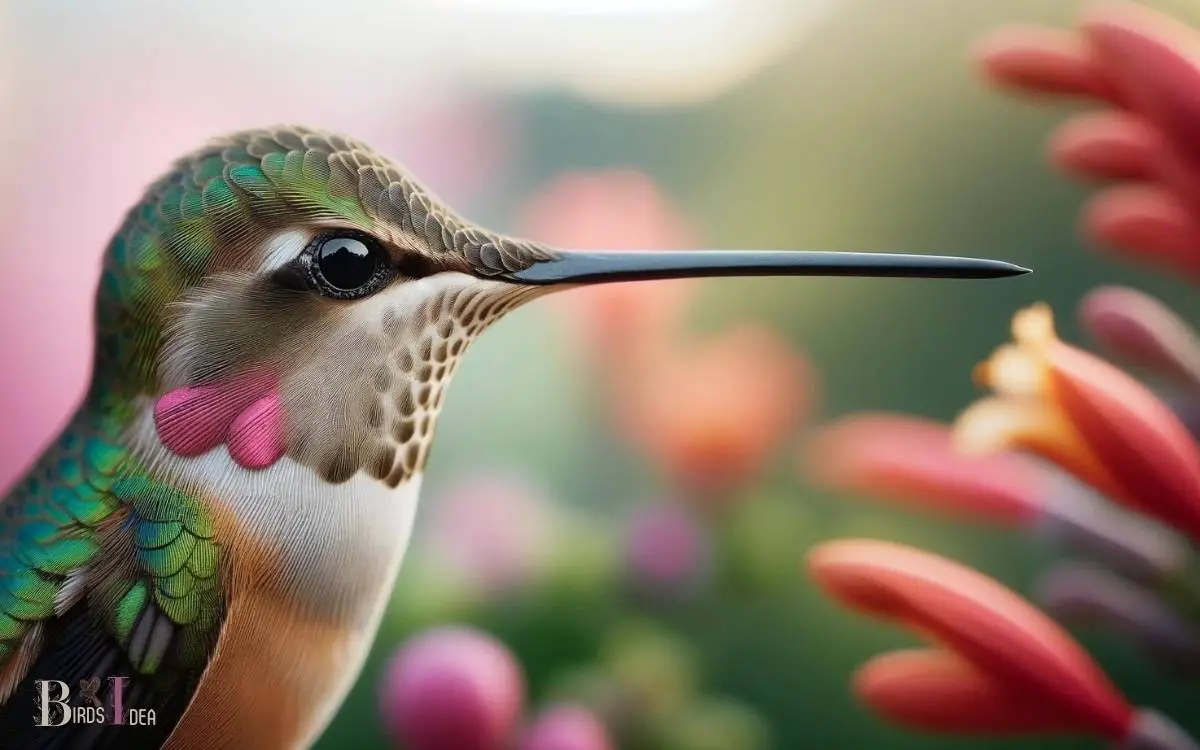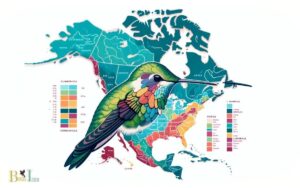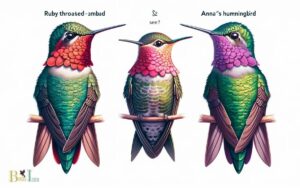Ruby-throated Hummingbird Beak Type: Straight, Lender Beak!
The Ruby-throated Hummingbird, known by the scientific name Archilochus colubris, has a long, straight, and slender beak. This specialized beak type is perfectly adapted for reaching into tubular flowers to access nectar, which is their primary food source.
Ruby-throated Hummingbirds, the only breeding hummingbird species in eastern North America, have evolved beaks that serve as an ideal tool for their feeding habits.
Their beak’s length and shape allow them to bypass the often lengthy and complex structures of flowers that have co-evolved with these birds to facilitate pollination.
The bird’s long tongue, which can extend well beyond the beak, is used to lap up nectar from deep within the bloom.
The slender beak of the Ruby-throated Hummingbird exemplifies the intricate relationship between avian species and their favored floral food sources, reflecting a remarkable instance of evolutionary adaptation.

Key Takeaway
8 Features Of Ruby-throated Hummingbird Beak
| Feature | Description |
|---|---|
| Common Name | Ruby-throated Hummingbird |
| Scientific Name | Archilochus colubris |
| Beak Shape | Long, straight, and very thin |
| Beak Length | Approximately 15-18 mm in adults |
| Beak Function | Adapted for nectar feeding; can reach deep into tubular flowers |
| Sexual Dimorphism | Males have a slightly shorter beak than females |
| Beak Flexibility | Limited; not as flexible as the beaks of some other bird species |
| Tongue | Long, grooved, and can extend far beyond the beak for feeding |
Anatomy of the Hummingbird Beak
The anatomy of the Ruby-throated Hummingbird’s beak includes a remarkable fusion of slender, elongated structure and specialized adaptations for nectar feeding. The beak is long and slender, perfectly suited for reaching deep into tubular flowers to extract nectar.
The upper and lower mandibles are both highly flexible and can open wide to accommodate the insertion of the beak into flowers. The tip of the beak is slightly down-curved, allowing for precise feeding.
Additionally, the tongue of the hummingbird is grooved and can extend beyond the beak, aiding in the collection of nectar.
These anatomical features enable the hummingbird to access nectar from a wide variety of flowers, making it a highly efficient and specialized nectar feeder.
Adaptations for Nectar Feeding
How do the anatomical features of the Ruby-throated Hummingbird’s beak seamlessly integrate with its adaptations for nectar feeding?
The Ruby-throated Hummingbird’s beak is perfectly adapted for nectar feeding. Its long, slender shape allows it to reach deep into flowers to access nectar, while the slightly curved, pointed tip aids in efficient nectar extraction.
The upper and lower mandibles are both flexible and can open wide to engulf the entire length of the flower’s corolla.
Furthermore, the beak’s specialized structure enables the hummingbird to lap up nectar at a rapid rate, thanks to its tubular and extensible tongue.
This intricate adaptation allows for efficient nectar collection, supporting the hummingbird’s high metabolic needs. The beak’s precise design is a remarkable example of evolutionary adaptation for specialized feeding behaviors.
Role in Pollination
The Ruby-throated Hummingbird’s beak plays a crucial role in pollination due to its specialized shape and movement patterns. The long, slender bill of the Ruby-throated Hummingbird is perfectly adapted for reaching deep into tubular flowers to access nectar.
As the bird feeds, its head comes into contact with the reproductive structures of the flower, transferring pollen from one bloom to the next.
Additionally, the bird’s rapid and agile flight allows it to visit numerous flowers in a short amount of time, increasing the likelihood of pollination.
This unique relationship between the hummingbird and the flowers it feeds on contributes significantly to the reproductive success of many plant species.
Understanding the role of the hummingbird’s beak in pollination sheds light on its feeding behavior and techniques.
Feeding Behavior and Techniques
Featuring remarkable agility and precision, the Ruby-throated Hummingbird utilizes its specialized beak and rapid flight to efficiently extract nectar from flowers and facilitate pollination.
Their feeding behavior involves hovering in front of flowers and inserting their long, slender beak deep into the flower to reach the nectar.
This process requires precise control of their flight muscles and exceptional visual acuity to locate and access the nectar within the often intricate structure of flowers.
The hummingbird’s long, extendable, and highly specialized tongue then laps up the nectar at a remarkable rate of up to 13 licks per second.
This feeding technique not only sustains the hummingbird but also plays a crucial role in the pollination of the flowers, making them valuable contributors to the ecosystem.
Comparison With Other Bird Beak Types
When compared to other bird species, the Ruby-throated Hummingbird’s beak type exhibits unique adaptations that enable it to efficiently extract nectar from flowers and play a significant role in pollination.
This specialized beak distinguishes the Ruby-throated Hummingbird from other birds in several ways:
- Long and slender: Unlike the powerful, seed-cracking beaks of finches, the hummingbird’s beak is long and slender, allowing it to reach deep into flowers to access nectar.
- Flexible: The hummingbird’s beak is highly flexible, enabling it to probe different flower shapes and sizes, unlike the sturdy, conical beaks of seed-eating birds.
- Sensitive tip: The hummingbird’s beak tip is highly sensitive, allowing it to precisely locate nectar within flowers, a feature not found in most other bird beak types.
- Narrow and tubular: The hummingbird’s beak is narrow and tubular, perfectly adapted for sipping nectar, unlike the broader, robust beaks of birds that crack open seeds.
Conclusion
The ruby-throated hummingbird’s beak is uniquely adapted for nectar feeding and plays a crucial role in pollination.
Its long, slender, and curved beak allows for efficient extraction of nectar from flowers, while its specialized tongue aids in the collection of this sugary substance.
Interestingly, it has been estimated that a ruby-throated hummingbird may visit up to 1,000 flowers in a single day, highlighting the important role it plays in pollination.






